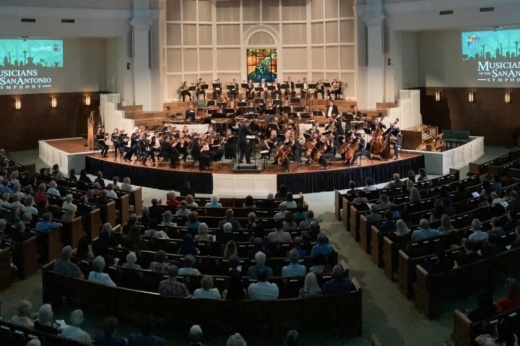San Antonio-based performing arts organizations are voicing disappointment over the recently announced closure of the San Antonio Symphony, whose union members were unable to reach a new contract with symphony management following more than one year of negotiations.
But the same arts groups tell Community Impact Newspaper that the dissolution of the symphony will not deter them in their efforts to further promote classical music across the San Antonio area.
On June 16, Symphony Society of San Antonio board announced the symphony’s dissolution and filing for Chapter 7 bankruptcy, ending an era of professional musicians locally performing orchestral music that dates back to 1887.
The San Antonio Symphony, as it had been known the past 83 years, endured an abbreviated 1987-88 performance season and canceled the 2003-04 season after filing for bankruptcy. But this latest news of permanently shuttering the symphony left San Antonio’s arts community reeling, artists said.
The symphony board blamed the musicians union for refusing to return to the bargaining table, calling the union’s contract demands fiscally unrealistic.
“The musicians union has made it clear there is no prospect of the resumption of negotiations, absent the board agreeing to a budget that is millions of dollars in excess of what the symphony can afford,” the symphony society stated.
The organization Musicians of the San Antonio Symphony claimed the board and management were committed to downsizing the group from that of a full-time, comprehensive professional orchestra to a part-time orchestra typically found in cities smaller than San Antonio.
“When the musicians refused to participate in our own destruction, our board and management elected to burn the house down rather than move from their insupportable position,” the musicians group stated.
The musicians group disputed other assertions made by symphony officials, saying Symphony Society leaders failed to raise the funds needed to grow and maintain a full-size professional symphony orchestra according to the city’s growth over the years.
The union also disputed symphony management’s claim that “the absence of a labor contract” forced the symphony’s closure with the musicians group saying the existing collective bargaining agreement was not due to expire until Aug. 31.
'A huge blow'
Local performing arts groups contacted by Community Impact Newspaper said regardless of assertions and counterclaims from symphony management and musicians, San Antonio deserves a major, full-time professional symphony orchestra.
Anya Grokhovski, CEO and artistic director of Musical Bridges Around the World, said dissolution of the San Antonio Symphony marks a major cultural and artistic loss for a midsize cosmopolitan city.
“We deserve a world-class symphony, and we had it,” Grokhovski said.
Grokhovski said it is important to understand what a professional symphony brings to a community. One benefit of having a symphony, she said, is boasting an exceptional level of musical ability.
Grokhovski said many San Antonio Symphony musicians hail from around the country or world with many now looking to see what comes next in their career.
"All of the symphony musicians are the best of the best. They bring with them musical knowledge,” she said.
Grokhovski said losing the symphony marks a “troublesome” trend in San Antonio highlighted by a lack of collective community support for the local performing arts.
“Our sized city should have more things, more opportunities, for musicians,” she added.
Donald Mason, the executive director of the Classical Music Institute, said he hopes nobody loses faith in San Antonio’s arts scene in spite of the symphony’s closure.
"Losing one organization won’t diminish the work that so many groups have done in building up the city,” Mason said.
Roland Barrera, the executive director of the San Antonio Chamber Choir, said losing the symphony felt like “a personal blow” but that it was not entirely surprising considering the San Antonio Symphony’s struggles in recent decades.
“Symphonies are the bedrock and cultural cornerstone in many communities,” Barrera said.
Cory McRae, president of the Alamo City Performing Arts Association's board, echoed Grokhovski’s sentiment, saying the San Antonio Symphony had brought many high-caliber professional musicians to town but now the local arts community is coping with “an extreme loss.”
Margery Huston of the San Antonio Tuesday Musical Club said she and her organization are “devastated” by the symphony’s end.
“It’s a huge blow to the culture of the city,” she said.
Jerrod Price, executive director of the Youth Orchestras of San Antonio, said the loss of any symphony in a city is devastating. He added symphony orchestras serve a vital community role by providing engaging experiences that leave concertgoers inspired to make positive change.
“Consumers of symphonic music leave with an extra spring in their step after hearing an uplifting performance. They temporarily suspend their troubles and dream of a life more fulfilled and complete. This ultimately leads to a more positive, inspired and vibrant community,” Price said.
Price said the loss of the symphony can be felt also in the attraction or retention of top-level private music instructors.
“In San Antonio, many of our finest master teachers are orchestral musicians who moved to San Antonio and found primary employment with the symphony. While we still boast many excellent private instructors, to know that we will not be recruiting new artist-teachers to a career and musical life in San Antoino is concerning for our future,” Price said.
Optimism about the arts
But the leaders of these performing arts organizations said they remain committed to picking up where the San Antonio Symphony left off, collaborating with each other and other groups, venues and institutions to keep promoting classical music. Some of the same arts groups also plan to work with symphony members.
Organizations contacted by Community Impact Newspaper say, the San Antonio area has seen the rise of classical performing arts groups such as SOLI Chamber Ensemble, South Texas Symphony Orchestra and the Olmos Ensemble over the last 25 to 30 years. Plus, the Cactus Pear Music Festival, a locally created summer classical music event, recently marked its 26th edition.
For organizations such as the Classical Musical Institute, that means a stronger emphasis on offering classical music education and orchestral performances across the San Antonio area, Mason said.
Founded originally as the Chamber Orchestra of San Antonio in 2009, the CMI debuted in 2016, having identified artistic and cultural gaps especially in orchestral education around the community.
“We just have to do whatever we can as an organization and find ways to collaborate and show unity and togetherness,” Mason said.
Another key to promoting classical music is making it inclusive, Mason said, explaining the CMI has offered live performances in far-ranging sites, such as Trinity University, the Edgewood ISD Performing Arts Center and the Cave Without a Name near Boerne.
Tickets for performances offered by the CMI are affordable with individual prices ranging from $10 for students, $25 for seniors and active military personnel, and $35 for adults, Mason said.
“We want to reach people where they are and make sure that ticket prices are not a barrier,” Mason said.
Barrera said his chamber choir, which performs in various venues with a repertoire ranging from the 15th to the 21st centuries, is prepared to help grow classical music locally.
“We seek to provide an outlet for patrons who want to experience and love classical music,” he said.
Barrera said the chamber choir looks forward to collaborative opportunities. The choir also plans to employing some symphony musicians for its scheduled performances of Handel’s “Messiah” on Dec. 17-18 at Missionary Oblates of Mary Immaculate.
“Our organization is ready to step up to the challenge,” Barrera said.
In a long-range view, Barrera said the chamber choir continues to offer concerts in various communities and event spaces as part of the organization’s aggressive outreach efforts. This includes the chamber choir’s Alamo City Street Choir, which provides a musical outlet for individuals experiencing homelessness.
“Our priority is to make meaningful relationships in the community,” Barrera said.
Collaboration and expanding public access to the performing arts have been primary missions for the ACPAA, the umbrella organization for the Alamo City Dance Co., the hybrid ballet/concert orchestra Alamo City Symphony Viva, Alamo City Arts Academy and the Heart of Texas Concert Band.
According to McRae, some San Antonio Symphony members have performed in the ACPAA’s presentation of “The Nutcracker.”
McRae said his nonprofit will help to support former symphony musicians however possible.
“If you can help another arts organization, you do it. A strong arts community is better for the city,” he said.
The ACPAA will widen access to classical music and local performing arts when the umbrella organization takes over operations of the Scottish Rite Cathedral in downtown San Antonio, McRae said. The nearly century-old structure has housed a variety of activities, including choir and classical music concerts, over the years.
“We want to make sure there’s access to the arts for everyone,” McRae said.
According to Grokhovski, Musical Bridges is a nonprofit that is on a mission to expose San Antonians to multicultural performing and visual arts.
Grokhovski said her organization does help to support expansion of classical music and overall arts education and fulfillment across the community.
Grokhovski said she believes San Antonio will have a symphony again, but future symphony groups should be structured in a way that allows the group to be financially sustainable and to expand its reach.
But Grokhovski also said it is important for local performing arts patrons—from casual fans to philanthropists—to understand the importance of supporting a growing city’s arts and culture.
“I don’t believe there isn’t enough money in San Antonio to support high-end art,” she added.
Huston expressed confidence that a new symphony will arise in San Antonio. Meanwhile, the Tuesday Musical Club will keep promoting and performing music as a fine art and advocating for more musical education in schools, Huston said.
“Getting music into the classroom is a huge thing. Music is important in the formation of the brains of young people,” Huston said.
Price shared Huston’s sentiment that symphony orchestras can have a significant generational effect on young people. He added music programs help a community to culturally evolve by demanding excellence and inspiring greater outcomes.
“Symphony orchestras have inspired generations of young people to pursue their passions, strive for excellence and establish higher career trajectories,” Price said.
Price said YOSA is hopeful and committed to a thriving local classical music scene. According to Price, YOSA is urging the public to support the Musicians of the San Antonio Symphony group by attending future performances, exploring partnerships and even utilizing the musicians’ expertise in YOSA’s programming.
The MOSAS Performance Fund is a nonprofit created to support Musicians of the San Antonio Symphony performances.
“In addition, YOSA will continue its tradition of providing truly excellent symphonic concerts for the community up to six times a year. We will look to our artistic partners to find high quality collaborations and inspire audiences,” Price said.
Price said YOSA is exploring new ways to reach local audiences, particularly youngsters and young adults.
“Whether that is student rush tickets, deepening our partnerships with school band and orchestra teachers, or performing more in the community, we will work to do our part,” he added.





